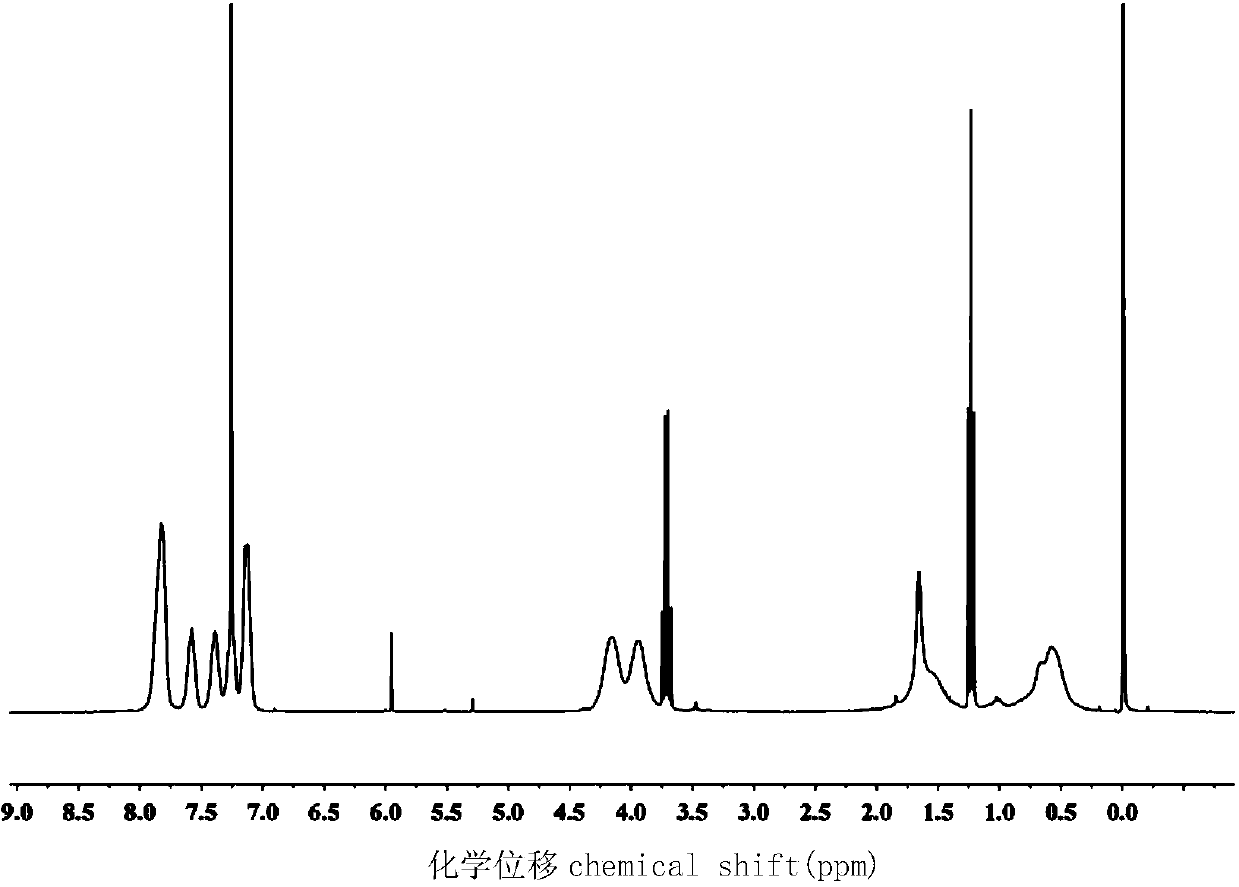Inflaming retarding segmented copolymer containing phosphorus and silicon and preparation method thereof
A technology of block copolymers and polymer chains, applied in the field of phosphorus-containing silicon flame-retardant block copolymers and its preparation, can solve problems such as secondary hazards and large amounts of hydrogen halide gas, achieve mild reaction conditions, and improve compatibility The effect of resistance and flame retardancy
- Summary
- Abstract
- Description
- Claims
- Application Information
AI Technical Summary
Problems solved by technology
Method used
Image
Examples
Embodiment 1
[0033] 1) Synthesis of HEDOPO monomer
[0034] First DOPO (4.32g, 0.02mol) and carbon tetrachloride (3.692g, 0.024mol) were mixed, added to 20ml of dichloromethane solvent and stirred with a magnet, and hydroxyethyl methacrylate (3.1234g, 0.024mol ) and triethylamine salt (2.4272g, 0.024mol) solution were mixed and added to the former, and ice-bathed, reacted at room temperature for 24 hours after a period of time, filtered, washed with NaOH solution for 3 times, and then washed with deionized water 2 times to get HEDOPO monomer.
[0035] 2)PHEDOPO 100 Synthesis of Macromolecular Chain Transfer Agents
[0036] Dissolve HEDOPO (1.376g, 4mmol), CDB (0.0109g, 0.04mmol) and AIBN (0.00164g, 0.01mmol) in 5mL of tetrachloroethane, and after continuous freeze-thaw degassing for 5 times, under argon protection, Polymerize at 65°C. After 24 hours of reaction, quench with liquid nitrogen to stop the reaction. Use 15 times the volume of 90mL ethanol as the precipitating agent to repeat...
Embodiment 2
[0040] 1) Synthesis of HEDOPO monomer
[0041] First DOPO (2.16g, 0.01mol) and carbon tetrachloride (2.3076g, 0.015mol) were mixed, added to 10ml of dichloromethane solvent and stirred with a magnet, and hydroxyethyl methacrylate (1.9521g, 0.015mol ) and triethylamine salt (1.5179g, 0.015mol) solution were mixed and added to the former, ice-bathed, reacted at room temperature for 24 hours after a period of time, filtered, washed with NaOH solution for 3 times, and then washed with deionized water for 2 times, to obtain HEDOPO monomer.
[0042] 2)PHEDOPO 50 Synthesis of Macromolecular Chain Transfer Agents
[0043]Dissolve HEDOPO (1.376g, 4mmol), CDB (0.0218g, 0.08mmol) and AIBN (0.00328g, 0.02mmol) in 5mL of tetrachloroethane, and after continuous freeze-thaw degassing for 5 times, under argon protection, Polymerize at 65°C. After 24 hours of reaction, quench with liquid nitrogen to stop the reaction. Use 15 times the volume of 90mL ethanol as the precipitating agent to rep...
Embodiment 3
[0047] 1) Synthesis of HEDOPO monomer
[0048] First DOPO (2.16g, 0.01mol) and carbon tetrachloride (1.3014g, 0.01mol) were mixed, added to 10ml of dichloromethane solvent and magnetically stirred and mixed, and hydroxyethyl methacrylate (1.5384g, 0.01mol ) and triethylamine salt (1.0119g, 0.01mol) solution were mixed and added to the former, and ice-bathed, reacted at room temperature for 24 hours after a period of time, filtered, washed with NaOH solution for 3 times, and then washed with deionized water for 2 times, to obtain HEDOPO monomer.
[0049] 2)PHEDOPO 80 Synthesis of Macromolecular Chain Transfer Agents
[0050] HEDOPO (2.752g, 8mmol), CDB (0.0272g, 0.1mmol) and AIBN (0.00328g, 0.02mmol) were dissolved in 5mL of tetrachloroethane, and after continuous freeze-thaw degassing for 5 times, under the protection of argon, the Polymerize at 65°C. After 24 hours of reaction, quench with liquid nitrogen to stop the reaction. Use 15 times the volume of 90mL ethanol as the...
PUM
 Login to View More
Login to View More Abstract
Description
Claims
Application Information
 Login to View More
Login to View More - R&D
- Intellectual Property
- Life Sciences
- Materials
- Tech Scout
- Unparalleled Data Quality
- Higher Quality Content
- 60% Fewer Hallucinations
Browse by: Latest US Patents, China's latest patents, Technical Efficacy Thesaurus, Application Domain, Technology Topic, Popular Technical Reports.
© 2025 PatSnap. All rights reserved.Legal|Privacy policy|Modern Slavery Act Transparency Statement|Sitemap|About US| Contact US: help@patsnap.com



